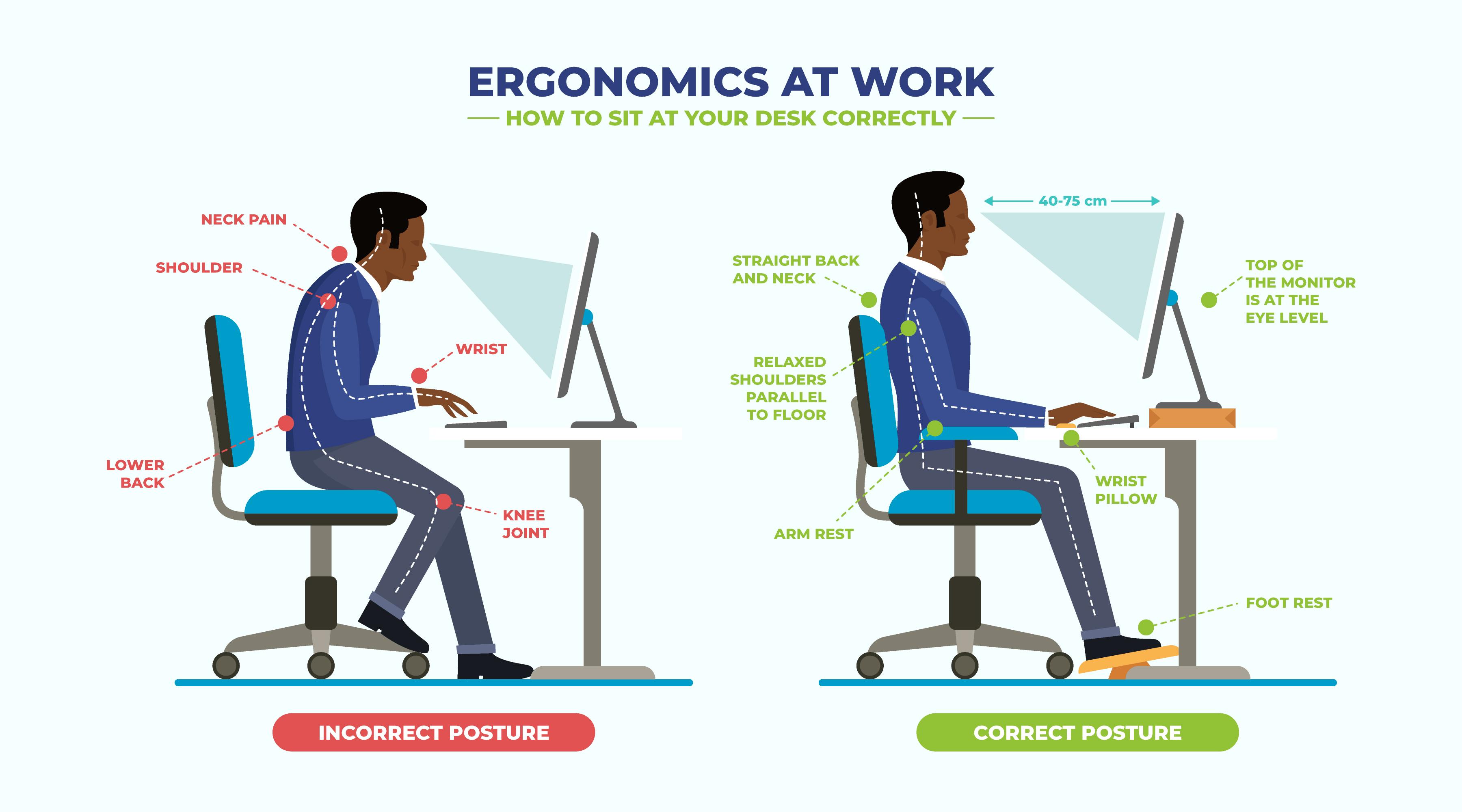Working in an office, whether at home or in a corporate environment, means spending a lot of time sitting. Unfortunately, without the proper setup, this can lead to aches, pains, and even long-term health issues. This is why understanding office ergonomics is essential.
| Aspect | Description |
|---|---|
| Understanding Ergonomics | The principles and importance of ergonomics in the workplace. |
| Ergonomic Office Furniture | How to choose the best desks, chairs, and monitors for comfort and productivity. |
| Ergonomic Accessories | Additional tools like mouse, keyboard, and footrests to enhance ergonomic setup. |
| Workspace Design | Optimizing office layout, lighting, and noise control for better ergonomics. |
| Healthy Work Habits | Incorporating breaks, stretches, and movement into the workday. |
| Technological Tools | Software and assessment tools to promote ergonomic practices. |
| Challenges and Solutions | Addressing common obstacles in implementing ergonomic strategies. |
| Case Studies | Real-world examples of successful ergonomic practices. |
| Buying Guide | Tips on purchasing ergonomic products and a look at sales data. |
| Future Trends | Explorations of upcoming innovations in office ergonomics. |
Introduction
Importance of office ergonomics
Spending hours at your desk can lead to discomfort and health issues. Ergonomics offers solutions to make office work more comfortable, productive, and healthy. In today's world, where many work from home and spend much of their day sitting, understanding office ergonomics has never been more important.
Chapter 1: Understanding Ergonomics
Definition and History
Ergonomics is the science of designing the workplace to fit the worker's needs. It aims to enhance comfort, safety, and productivity by reducing strain and injury. The concept has been around for centuries, but modern ergonomics began in the 1950s.
Key Principles
Fit, alignment, and movement are key ergonomic principles. This means arranging your workspace to fit your body's dimensions, maintaining proper alignment while working, and incorporating movement throughout the day.
Relevance in Modern Workspaces
With the rise of technology and remote work, understanding ergonomics is essential for creating a healthy and productive work environment.
Chapter 2: Ergonomic Office Furniture
Ergonomic Desk
Types of Desks: Choose adjustable height or standing desks for flexibility. An ergonomic desk allows you to align it with your height and work preferences.
Recommended Height and Positioning: Your desk should be at elbow height, and your monitor should be eye level to reduce neck strain.
Ergonomic Chairs
Features: Look for lumbar support, adjustable height, and swivel functions. Proper sitting posture is essential for reducing back pain. Ensure the chair supports the natural curve of your spine.

Comprehensive Office Guide offers detailed instructions on optimizing your office setup.
Monitors and Screens
Ideal Screen Placement: Your monitor should be about an arm's length away, with the top of the screen at eye level. This helps maintain a neutral neck position. For dual monitor setups, place them at the same height and angle to avoid neck strain.
Chapter 3: Ergonomic Accessories
Mouse and Keyboard: Ergonomic designs reduce wrist strain. Place them within easy reach to maintain a natural hand position.
Footrests and Anti-Fatigue Mats: Use footrests to support your feet and keep your legs level. Anti-fatigue mats are great for standing desks to reduce leg strain.
Monitor Arms and Standing Desk Converters: These accessories let you adjust the height and position of your screens and desks, promoting better posture and flexibility.
Chapter 4: Workspace Design
Optimal Office Layout
Ideal Spacing and Arrangement: Organize your workspace to minimize clutter and maximize efficiency. Keep frequently used items within arm's reach.
Lighting and Noise
Importance of Natural Light: Good lighting reduces eye strain and improves mood.
Noise Reduction Techniques: Use noise-cancelling headphones or office partitions to minimize distractions.
Tech Innovations for Home Offices discuss advanced lighting and noise-cancellation technologies to enhance ergonomics.
Blue light glasses can help minimise the effects of staring at screens all day.
Chapter 5: Healthy Work Habits
Regular Breaks
Frequency and Types: Take short breaks every hour to rest your eyes and stretch your body. This prevents strain and boosts productivity.
Stretching Exercises
Incorporate simple stretches into your routine to alleviate muscle tension. Focus on your neck, shoulders, back, and legs.
Movement Tips
Encourage standing and walking during work hours. Use a standing desk or take phone calls while standing.
Chapter 6: Technological Tools for Ergonomics
Software Reminders: Use apps and software to remind you to take breaks and adjust your posture. These tools help maintain healthy habits.
Ergonomic Assessment Tools: Evaluate your workspace with ergonomic assessment tools to identify areas that need improvement.
Chapter 7: Challenges and Solutions
Budget Constraints: Know that ergonomic solutions can be found at various price points. Prioritize essential items like chairs and desks. You can look at desk converters instead of buying a standing desk and recycling your desks.
Limited Space: Use compact ergonomic furniture and accessories. Multi-functional furniture can maximize space efficiency.
Resistance to Change: Educate yourself on the long-term benefits of ergonomics to overcome reluctance.
Chapter 8: Real-World Examples and Case Studies
Companies that have implemented ergonomic practices report increased employee satisfaction and productivity. Employees also share positive testimonials after transitioning to ergonomic workspaces.
Chapter 9: Buying Guide
Choosing the Right Products: Look for adjustable, supportive, and high-quality ergonomic products.
Trusted Brands and Products: Research reputable brands known for ergonomic excellence.
Data Visualization North America Ergonomic Chair Market Source Spherical Insights:

Chapter 10: Future Trends in Office Ergonomics
Emerging Technologies: Expect innovations like smart desks and chairs with built-in sensors and AI-driven adjustments.
Predictions: The future of ergonomic workplaces looks promising with advancements in technology and growing awareness of health benefits.
Conclusion
Understanding and applying ergonomic principles in the office helps prevent discomfort and health issues, leading to a more productive and enjoyable work environment. Make the commitment to invest in ergonomic practices for a healthier workspace.

